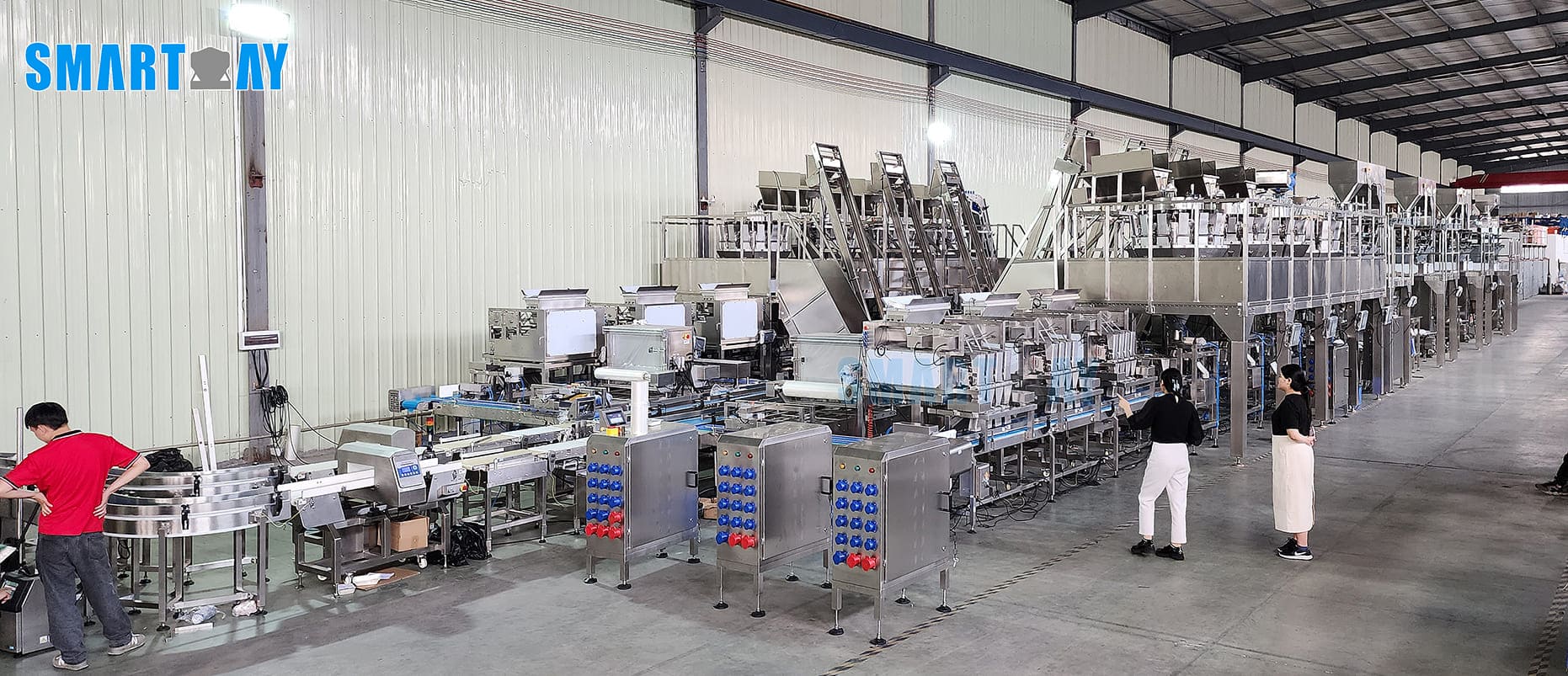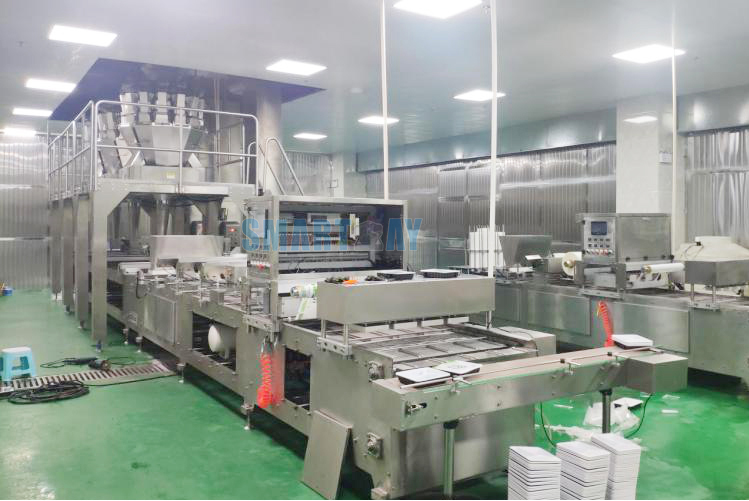Since 2012 - Smart Weigh is committed to helping clients increase productivity at a reduced cost. Contact us Now!
Since 2012 - Smart Weigh is committed to helping clients increase productivity at a reduced cost. Contact us Now!
When selecting a ready meal packaging machine manufacturer, there are many factors to consider that ensure efficiency, product safety, and long-term reliability. After all, from production capacity to packaging materials, the right manufacturer can help streamline operations to increase product quality.
Over the years, the growing demand for ready meals has led to an increase in packaging innovations. Choosing a manufacturer who understands industry trends and provides cutting-edge technology is critical to staying competitive in today’s market.

The first is to understand the ready meal packaging style for your meals, as it impacts both product presentation and preservation. So, if it's trays, pouches, or vacuum-sealed packs, the right format should align with your product and target market.
Ready meal packaging comes in a variety of formats like standup pouches, vacuum pouches, MAP (Modified Atmosphere Packaging), skin packs, and heat-sealed trays. Whatever format you select depends on factors such as shelf life, portion size, and the type of food being packaged.
There are many manufacturers that offer ready meal packing machines capable of meeting your current production needs while allowing room for future scalability. Ensuring the machine can handle both small and large production volumes is essential for growth.
Manufacturers that offer customizable packaging solutions allow you to tailor machines to specific requirements, such as labeling, sealing techniques, or integrating new technologies. This flexibility ensures the machine meets your unique operational demands.
Choosing a ready meal packing machine requires a close look at its technological capabilities, including its automation, speed, flexibility, and compliance with hygiene standards. These features directly influence operational efficiency.
Automation grade is the first point to be considered, most of
Manufacturers er output, which is crucial for businesses handling large orders of ready-to-eat meals.
Always select ready to eat food packaging machines equipped with servo-driven technology, which provides precise control over packaging speeds and minimizes downtime. the volume of production and ascertain whether a fully automated packing line is necessary to satisfy the increasing demand or if a semi-automatic system is adequate.
Automated systems with integrated PLC (Programmable Logic Controller) and HMI (Human-Machine Interface) panels allow real-time monitoring for enhanced efficiency, and a higher automation grade can significantly reduce human labor, limit errors, and ensure speed. Semi-automated systems are popular on the market right now, but Smart Weigh offers a fully automatic weighing and packing system for ready to eat foods.
A good machine should support multiple packaging formats, such as MAP (Modified Atmosphere Packaging), vacuum skin packaging, or heat-sealed trays. So, machines that allow quick format changes with tool-free systems or multi-format capabilities always reduce setup time between different packaging styles.
To meet HACCP (Hazard Analysis and Critical Control Points) standards, machines should feature stainless steel construction and have IP69K-rated components for easy washdown and cleaning. This ensures the equipment meets stringent hygiene requirements to prevent cross-contamination in food packaging environments.
Industry 4.0 integration is revolutionizing packaging machines with advanced software capabilities, improving operational transparency, data collection, and predictive maintenance. Ready meal packaging machines that are Industry 4.0-ready provide greater efficiency and control over the production line.
IoT-enabled packaging machines allow remote monitoring and diagnostics, enhancing real-time decision-making. These machines are equipped with sensors that track key performance metrics and communicate through cloud-based platforms to enable predictive maintenance and minimizing downtime. At the same time, it gets easier to handle all the related data and point out any malfunctioning error, if that happens.
Ensure your packaging machine uses open communication protocols like OPC UA (Open Platform Communications Unified Architecture) for seamless connectivity with upstream and downstream equipment such as filling machines or labeling systems. This ensures efficient synchronization and data sharing across the entire production line.
Reliable after-sales support should be the number one priority for maintaining the long-term performance of your ready meal packing machine. Smart Weigh is a credible manufacturer, which offers comprehensive service plans to ensure optimal machine functionality.
As a buyer, always go for the manufacturer with a global distribution network for spare parts and responsive repair services. Quick access to OEM (Original Equipment Manufacturer) parts ensures minimal disruption and prevents costly delays in production due to machine malfunctions. After all, if there’s a disruption and technical fault, it takes long time to get it repaired and in a fast-paced working environment, no company can afford that.
A robust training program for your team, paired with scheduled preventive maintenance plans, can extend the life of your machine. Look for manufacturers that offer on-site training, technical documentation, and regular software updates to ensure your equipment operates at peak performance.
At the end of the day, it is all about evaluating the total cost of ownership (TCO) and return on investment (ROI) when purchasing ready meal food packaging machines. Therefore, the upfront costs of the packaging machine should balance out long-term benefits in the longer run.
While initial costs for advanced packaging machines may be high, investing in energy-efficient models with automation capabilities can result in lower operational expenses over time. Machines with lower power consumption and faster cycle times help improve long-term efficiency and reduce production costs.
Comprehensive warranty packages and low-maintenance designs reduce unforeseen repair costs and downtime. Therefore, you should go for machines that offer extended warranties on critical components and include service agreements for consistent performance and protecting your long-term investment.

Selecting the right ready meal packaging machine manufacturer involves evaluating factors such as packaging flexibility, automation, and compliance with hygiene standards. A good machine should also integrate seamlessly with other equipment and be ready for Industry 4.0 advancements, enhancing long-term efficiency and productivity.
Maintenance, after-sales support, and access to spare parts are equally crucial for maintaining your machine's longevity and minimizing downtime. The total cost of ownership and return on investment should be carefully assessed to ensure that initial costs balance out with long-term operational savings.
For a trusted and innovative solution, consider Smart Weigh, which offers machines like the automatic tray packing line for ready meals, central kitchen ready to eat food packaging machine, fried rice vacuum premade bag rotary packaging line and instant rice noodles packing line. their advanced technologies ensure high performance, efficiency, and reliability in ready meal packaging.
CONTACT US
Building B, Kunxin Industrial Park, No. 55, Dong Fu Road , Dongfeng Town, Zhongshan City, Guangdong Province, China ,528425
How We Do It Meet And Define Global
Related Packaging Machinery
Contact us, we can give you professional food packaging turnkey solutions

Copyright © Guangdong Smartweigh Packaging Machinery Co., Ltd. | All Rights Reserved